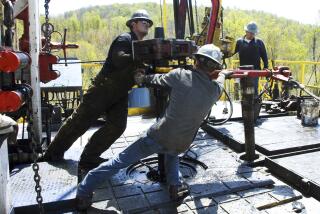In Alaska, the Hunt for Oil, Gas Only Begins at Wildlife Refuge
CORDOVA, Alaska — As Congress prepares to square off over oil drilling in Alaska’s Arctic National Wildlife Refuge, a small company has quietly applied to drill 680 miles to the south, on the Copper River Delta.
It is hard to imagine a plan more likely to set off alarm bells with environmentalists, for the 700,000-acre delta is the most important shorebird stopover on the Pacific Coast--and home of the best-tasting salmon in the world.
But ramped-up oil and gas production now is possible in regions all over the Alaskan frontier--from the Copper River Delta and offshore sites along the Cook Inlet in the south to the frozen Beaufort Sea in the north. Some of the areas that previously held little interest for oil producers now are prime for exploration for two key reasons: soaring fuel prices and the support of a new, more business-friendly Republican administration.
The Arctic refuge is simply the first flash point. A GOP-drafted federal energy package, following President Bush’s lead, calls for drilling in the 1.5-million-acre coastal plain--a region so rich with wildlife that it is known as America’s Serengeti.
“Alaska has seen that, with a Republican administration and a Republican House and a Republican Senate, all the constellations have aligned for them,” said Allen Smith, Alaska regional director of the Wilderness Society. “They are preparing to have their day, and oil and gas are at the front of the line.”
No wonder that in his state of the state address last month, Alaska Gov. Tony Knowles--a Democrat but also a former oilman and Bush’s fraternity brother at Yale--proclaimed Alaska “on the verge of a new era.” Anchorage Mayor George Wuerch is unabashedly upbeat. “The Clinton era is over,” he said. “If you care about Alaska, our economic future is about to change.”
Like the Bush administration, Knowles believes in economic development--and says it does not have to come at the expense of the environment.
The governor has already pledged to expedite permit reviews for the nation’s single biggest energy development project in more than two decades: an $8-billion to $10-billion pipeline to carry natural gas from the North Slope down through Canada and the U.S. Midwest.
“Help is on the way,” Knowles told a conference of Western governors Friday in Portland, Ore.--noting that the pipeline will provide access to 36 trillion cubic feet of new natural gas, the largest proven reserves in North America.
But the fact that the cheapest way to build the pipeline is to bury it under the ocean off the coast of the Arctic refuge could make it nearly as controversial as drilling in the refuge itself. Knowles has backed a route that could be $2 billion more expensive, running down the existing trans-Alaska pipeline and well clear of the refuge.
Babbitt Delayed Oil Lease Sale
Other controversies are possible in the waters off Alaska’s shore as the federal Minerals Management Service in the coming months prepares its next five-year development program.
“Given this administration, I think it will be unlike anything we’ve ever seen,” said Jenna App, a lawyer with Trustees for Alaska who has challenged offshore drilling in the Beaufort Sea. “We’re potentially looking at Alaska pretty much on all sides being surrounded by [offshore] leasing.”
Two days before leaving office, former Interior Secretary Bruce Babbitt deferred a pending lease sale on nearly 10 million acres that could have allowed drilling in the Beaufort Sea off the Arctic refuge and the National Petroleum Reserve.
Since 1979, the government has issued 688 leases in the Beaufort Sea--although the first actual production well, known as Northstar, only now is nearing operation. Federal officials said it is not clear whether the new administration will seek to lift Babbitt’s deferral.
BP Exploration and Phillips Alaska--two of the biggest oil firms operating in the Arctic--admit they are setting their sights on the frozen Beaufort Sea, where there are substantial questions about the industry’s ability to clean up oil spills in the shifting, broken ice of spring and fall. And Phillips is eyeing expansion in the Cook Inlet, where heavy opposition until now has restricted most offshore drilling to the more developed, less ecologically sensitive upper inlet.
In an interview, Knowles said it was doubtful that the oil industry would seek to expand drilling much beyond the existing infrastructure. “Basically, drilling and extraction in Alaska is such an expensive proposition--and the environmental concerns are so great--there really has been a concentration on the area where there is an existing infrastructure” on the North Slope, he said.
With that in mind, the big oil companies are not ruling out expanding their footprint in the National Petroleum Reserve.
The 23-million-acre reserve, an area west of Prudhoe Bay, is in many ways as ecologically prized as the Arctic refuge. A little more than 4 million acres of the reserve were opened to oil production in 1998. But the Clinton administration banned drilling around the breathtaking raptor nests of the Colville River bluffs and around Teshekpuk Lake, the only molting habitat of its kind for millions of migratory waterfowl.
Given that a good share of the known oil reserves there are near the lake, many conservation groups predict companies will seek to shrink the 6-mile-wide buffer zone and expand drilling all over the reserve.
BP Exploration and Chevron are building 70 miles of temporary ice roads within the reserve to drill three exploratory wells this year. “If we have success in this effort, there’s a good chance that we will be seeking access to other areas” of the reserve, BP spokesman Ronnie Chappell said.
North Slope producers also say they will be undertaking major new oil development ventures within the existing Prudhoe Bay field. Thanks to higher oil prices and new technology, BP is preparing to tap as much as 20 billion barrels of viscous oil--equivalent to creating the second-largest oil field in the nation--that previously lay untouched.
Still, the poster child for expanded oil drilling in Alaska has been the Arctic National Wildlife Refuge. And the coming debate in Congress likely will emerge as the first big environmental battle of the Bush administration.
Bush has placed the refuge near the top of his program to develop new domestic energy sources--a plan sure to spark a showdown in Congress because protection of the refuge has become a line in the sand for environmentalists.
Refuge Rich With Wildlife, Birds
The 1.5-million-acre coastal plain on the refuge is a vital gathering point for wildlife. Millions of birds migrate to the Arctic each summer from as far away as South Texas, Argentina and Chile. The refuge shields polar bears, grizzlies, musk oxen, wolves and moose--in addition to providing a critical calving site for the 150,000 caribou of the porcupine herd that migrate as far as 800 miles from Canada each year.
“The oil industry will tell you we can have it all; that we can have the largest industrial oil facility in the U.S. and abundant birds and wildlife. But it’s simply not true,” said Sara Callaghan, the Sierra Club’s Arctic coordinator. “You have to put a place aside to allow the Arctic environment to do its own thing. The refuge is one of the only places left in the Arctic where wildlife has been growing and changing for thousands of years in a continuous natural cycle.”
The refuge is thought to be capable of producing anywhere from 650,000 to 1.9 million barrels a day, depending on the amount of oil ultimately found there. The North Slope sends about 1 million barrels of oil a day down the pipeline; the U.S. uses about 18.7 million barrels of oil a day. So whatever is recovered from the refuge would fall far short of rendering the country self-sufficient--although it certainly would help.
It also would do almost nothing to directly alleviate the current energy crisis in California. Yet a number of polls show that more and more Americans want to reduce the country’s dependence on foreign oil.
“People in the industry have been saying this for the last 10 years as background noise: ‘We have a problem coming, folks,’ ” said Judith Brady, director of the Alaska Oil and Gas Assn.
And the Arctic National Wildlife Refuge is the nation’s most visible answer to that problem.
Industry officials say technology that now allows wells to be set on a small pad and drilled horizontally for miles, along with temporary ice roads, could allow the refuge to be drilled with minimal effect or damage to the underlying tundra.
As for potential harm to the porcupine caribou herd, industry officials cite a recent study that showed a 35% increase in the size of the herd around existing oil operations at Prudhoe Bay. “Thirty years . . . at Prudhoe Bay have proved that production and wildlife can coexist,” said Cam Toohey, head of the industry lobbying group Arctic Power.
Drilling opponents argue that, although the caribou may have increased in numbers, they have experienced significant reductions in their productivity rate.
Similar wildlife concerns are being raised concerning the Copper River Delta, where the Chugach Alaska Corp. has proposed a small drilling operation.
The area was the site of Alaska’s first oil well, but it had stopped producing by the 1930s.
Since then, biologists have come to recognize the unusual habitat value of the delta. The largest wetlands complex on the Pacific Coast, it is home to 16 million migratory shorebirds and waterfowl--as well as large populations of wolves, lynx, sea lions, beaver, otter and mink.
“If this area was oiled, it could take out the entire Pacific Coast flyway, literally,” said Riki Ott, a marine biologist at Cordova and an opponent of oil drilling in the region. “We get 90% of the birds here. This is one of the two most important wetlands in the world, because it’s strategically located: They simply can’t miss it.”
Then there are the fabled Copper River runs of 2 million salmon. The Cordova fishing fleet, still reeling with the collapse of herring and pink salmon from the 1989 Exxon Valdez oil spill in Prince William Sound, brings in $13.5 million a year from the Copper River’s prized kings and sockeyes.
A 1982 native land claims settlement gave subsurface rights in a small part of the southern edge of the delta to Chugach Alaska, a Native American company. But the firm has only until 2004 to find paying quantities of oil on the site. Otherwise, subsurface rights on that and surrounding lands revert back to the federal government.
“It is an environmentally sensitive area, and any development there would have to be respectful of the other resources,” company spokesman Rick Rogers said. “But . . . the Chugach gave up substantial aboriginal land rights for a very small fraction of the lands they previously occupied. And part of that settlement was the ability for them to develop their own economic self-determination. They can call it wilderness if they want to, but Chugach still owns that land.”
Few expect the U.S. Forest Service, whose land surrounds the Chugach Alaska site, to block access. Indeed, a successful test well could mean the company would be entitled to develop oil on thousands of acres of public land in the delta.
The nearby town of Cordova already is drawing up battle lines. Half the town--especially the fishermen who rely on the Copper River salmon--wants oil development prohibited. The other half points out that Cordova is paying 23 cents per kilowatt-hour for electricity. They’re hoping for a share of the bonanza.
“You either develop it yourself,” said former Cordova Mayor Margy Johnson, “or you train every new president to get down on his hands and knees to go out and beg [Iraqi President] Saddam Hussein.”
More to Read
Sign up for Essential California
The most important California stories and recommendations in your inbox every morning.
You may occasionally receive promotional content from the Los Angeles Times.










